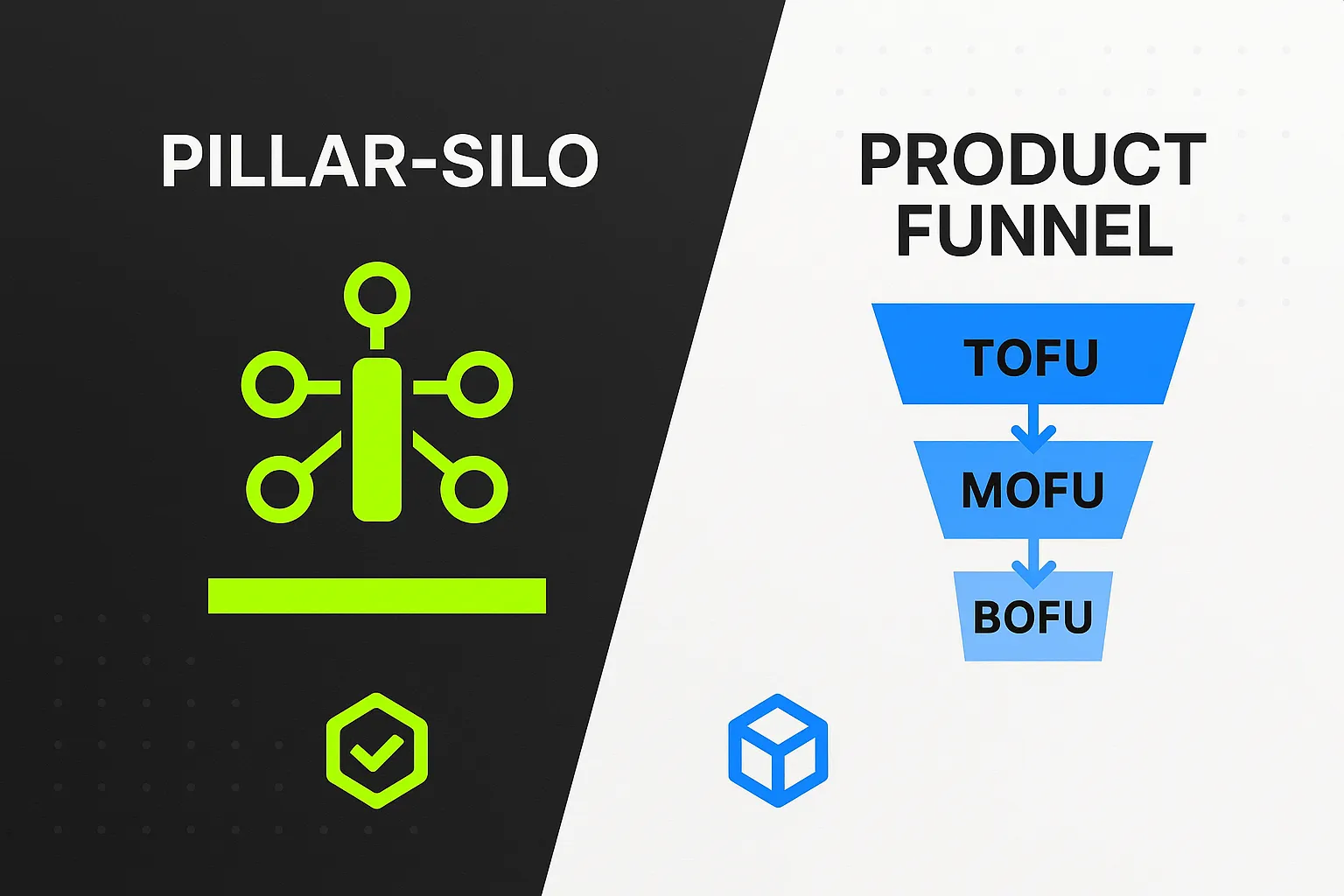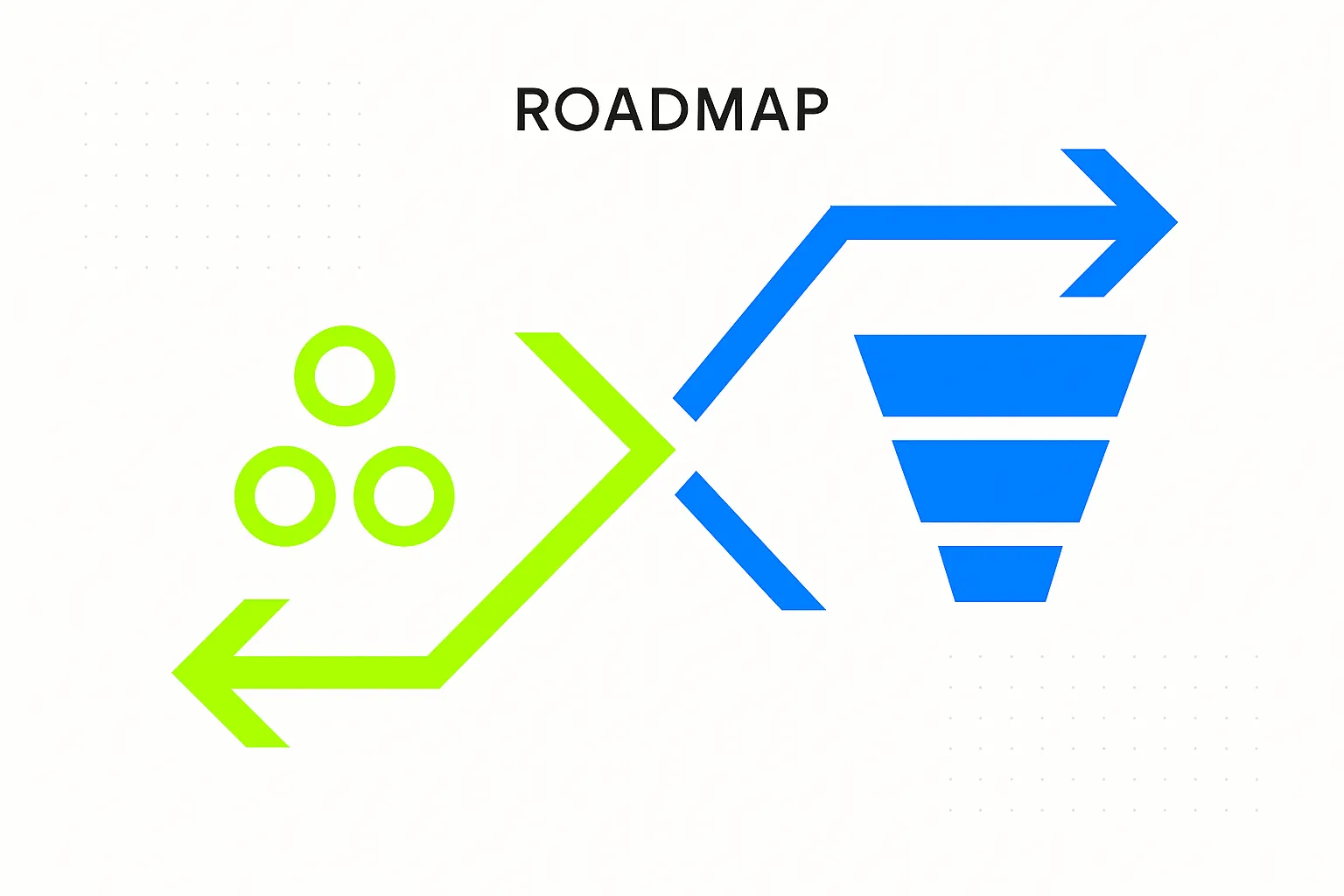Pillar-Silo vs. Product Funnel: Which AI Content Architecture is Right for Your Business Model?
AI Summary
Choosing between the Pillar-Silo model and the Product Funnel model is critical for aligning your content strategy with your business goals and maximizing conversions. This article explains these two AI-powered content architectures, their best use cases, and how AI can simplify your decision-making process.
- Who:
Business leaders, marketers, and strategists choosing a scalable content strategy. - What:
Comparing Pillar-Silo and Product Funnel AI content architectures tailored for different business models. - When:
During content planning stages or when optimizing marketing strategies for higher lead quality and sales velocity. - Where:
Across digital marketing landscapes including B2B, SaaS, e-commerce, and DTC markets. - Why:
To select a precise, AI-enhanced strategy that reduces risk, boosts authority, accelerates conversions, and drives sustained growth.
Choosing the right content architecture is one of the most critical decisions you will make for your business. It is not just a marketing task. It is a strategic choice that directly impacts lead quality, sales velocity, and ultimately, your bottom line. Get it right, and you can achieve up to 3x higher conversion rates. Get it wrong, and you are left with wasted resources and stagnant growth.
Many businesses struggle at this strategic crossroads, defaulting to a one-size-fits-all approach that fails to align with how their customers actually buy. The two dominant models, the Pillar-Silo and the Product Funnel, serve fundamentally different purposes. One builds unshakeable authority. The other engineers a high-conversion journey.
This guide will help you move beyond the generic advice. We will dissect each model, map them to specific business types, and show you how to make the right choice with confidence. We will also explore how AI is revolutionizing this process, making strategic selection faster, more accurate, and more profitable than ever before.
Decoding the Pillar-Silo Model: Building Unshakeable Topical Authority
The Pillar-Silo model, often called the topic cluster model, is designed for one primary purpose: to establish your business as the definitive authority on a specific subject in the eyes of search engines and customers. It organizes your content like a comprehensive library.
Here is how it works:
- Pillar Page: This is a long-form, foundational piece of content that provides a broad overview of a core topic. Think of it as the central hub, like a definitive guide to "Small Business Automation."
- Topic Clusters: These are shorter, more specific articles that explore subtopics related to the pillar in greater detail. For our example, clusters might include "Automating Invoicing," "Using AI for Customer Support," or "Best CRM Automation Tools."
- Internal Linking: Each cluster page links back to the main pillar page. This creates a powerful, interconnected web of content that signals deep expertise to Google. A well-executed internal linking strategy is crucial. One HubSpot user even reported an 800% click increase after properly implementing this structure.
This approach transforms your website from a collection of random blog posts into a structured, authoritative resource. It is a powerful way to dominate search rankings for competitive terms. Research shows that brands with clear content strategies including pillar content are 313% more likely to report marketing success.
Best for: Service-based businesses, B2B companies, complex SaaS solutions, and affiliate sites where building trust and demonstrating deep expertise is essential before a sale can occur.
Decoding the Product Funnel Model: Engineering High-Conversion Journeys
The Product Funnel model is engineered to guide a potential customer through a structured buyer’s journey, moving them systematically from awareness to purchase. It aligns content directly with the traditional sales funnel.
Here is the breakdown:
- Top-of-Funnel (TOFU): This content addresses a broad problem or question your audience has, without mentioning your product directly. Its goal is to attract and educate. Example: An e-commerce brand selling hiking boots might create an article on "The 10 Best Hiking Trails for Beginners."
- Middle-of-Funnel (MOFU): This content is for prospects evaluating solutions. It compares options, offers guides, and helps them define their needs. Example: "How to Choose the Right Hiking Boots: A Buyer’s Guide."
- Bottom-of-Funnel (BOFU): This content is designed to convert. It includes product pages, reviews, case studies, and comparisons that directly feature your solution. Example: "Why Our TrailBlazer Pro Boots Are the Best for Rocky Terrain."
This model is less about broad authority and more about targeted conversion. It meticulously maps content to user intent at each stage of the decision-making process. The evergreen content created for the TOFU and MOFU stages can be particularly valuable, often yielding a 4x higher ROI than short-term campaign content.
Best for: E-commerce stores, direct-to-consumer (DTC) brands, and simple SaaS products where the path to purchase is relatively linear and transactional.
Head-to-Head: A Comparative Analysis for Your Business Model
The right choice depends entirely on your business model, sales cycle, and customer's decision-making process. The goal is not to pick the "best" model, but the model that is best for you.

For Service-Based Businesses and Complex SaaS
If your business involves a longer sales cycle, high-ticket offers, and a need to build significant trust, the Pillar-Silo model is your strongest choice. Your customers are not making impulse buys. They are conducting extensive research to find a true expert. Your content needs to prove you are that expert. By covering a topic from every angle, you build the confidence required to generate high-quality, educated leads ready for a sales conversation.
For E-commerce and Direct-to-Consumer Brands
If you sell products directly to consumers, the Product Funnel model aligns perfectly with the customer journey. Your audience moves from problem awareness to product discovery and finally to a purchase decision. Your content must meet them at each step. A TOFU blog post might attract them, a MOFU comparison guide might convince them, and a compelling BOFU product page will close the sale. The architecture is built for transactional velocity.
The AI Revolution in Content Architecture: Beyond 'One-Size-Fits-All'
Manually analyzing your business model, competitors, and customer journey to choose and build the perfect content architecture is a complex and time-consuming process. A wrong turn can lead to months of wasted effort and significant financial loss. This is where AI changes the game entirely.
Instead of relying on guesswork or generic templates, an AI-driven system can perform this strategic analysis in a fraction of the time. At pageBody, our AI-powered SEO Strategist does exactly that. It conducts a deep dive into your business's unique DNA, analyzes competitor vulnerabilities, and maps the precise journey your customers take.

Based on this comprehensive intelligence, our system automatically selects and builds the optimal content architecture. Whether it is a robust Pillar-Silo to establish your authority or a high-conversion Product Funnel to drive sales, the strategy is perfectly tailored to your goals. This removes the risk of failure and ensures your content marketing efforts deliver exponential results from day one.
Conclusion: Making Your Strategic Choice with Confidence
Your content architecture is the foundation of your digital growth. A Pillar-Silo builds a fortress of authority, ideal for complex, trust-based sales. A Product Funnel creates a direct path to purchase, perfect for transactional businesses.
Understanding the difference is the first step. The next is making the right choice without hesitation. Relying on an advanced AI to analyze your unique situation de-risks this critical decision and positions you for sustained success. By aligning your content structure with your business model, you are not just creating content. You are building a powerful, automated engine for growth.

If you are ready to implement a content strategy that is precision-engineered for your business, discover how our AI SEO Strategist can build your path to market leadership.
Frequently Asked Questions
Is it possible to use a hybrid of both models?
Yes, a hybrid approach can be very effective for certain businesses. For example, a complex SaaS company might use a Pillar-Silo model to build authority around its core solution, while also creating a separate Product Funnel for a specific, lower-priced feature or add-on. The key is to have a clear strategic reason for doing so, which an AI analysis can help determine.
How does the rise of AI Overviews and LLMs affect which strategy I should choose?
Both models remain highly relevant. AI Overviews tend to synthesize information from authoritative sources, making the Pillar-Silo model even more valuable for establishing that authority. The Product Funnel model remains effective because it aligns with a specific, intent-driven user journey that still leads to transactional searches. A strong content architecture helps your content get surfaced in both traditional search and AI-driven results.
How long does it take to see results from implementing one of these architectures?
SEO is a long-term strategy, but results can appear faster with a correctly chosen and implemented architecture. Typically, you can expect to see initial positive signals like impression and traffic growth within 3 to 6 months. The Pillar-Silo model may take slightly longer to build full authority, while a targeted Product Funnel can sometimes generate BOFU conversions more quickly.
Does using an AI strategist mean I do not need a human marketing team?
AI is a powerful accelerator, not a total replacement. Our AI handles the complex strategic analysis, architecture selection, and content mapping that is often prone to human error. This frees up your human team to focus on higher-value tasks like creative direction, brand voice, and building customer relationships, making your entire marketing operation more efficient and effective.


